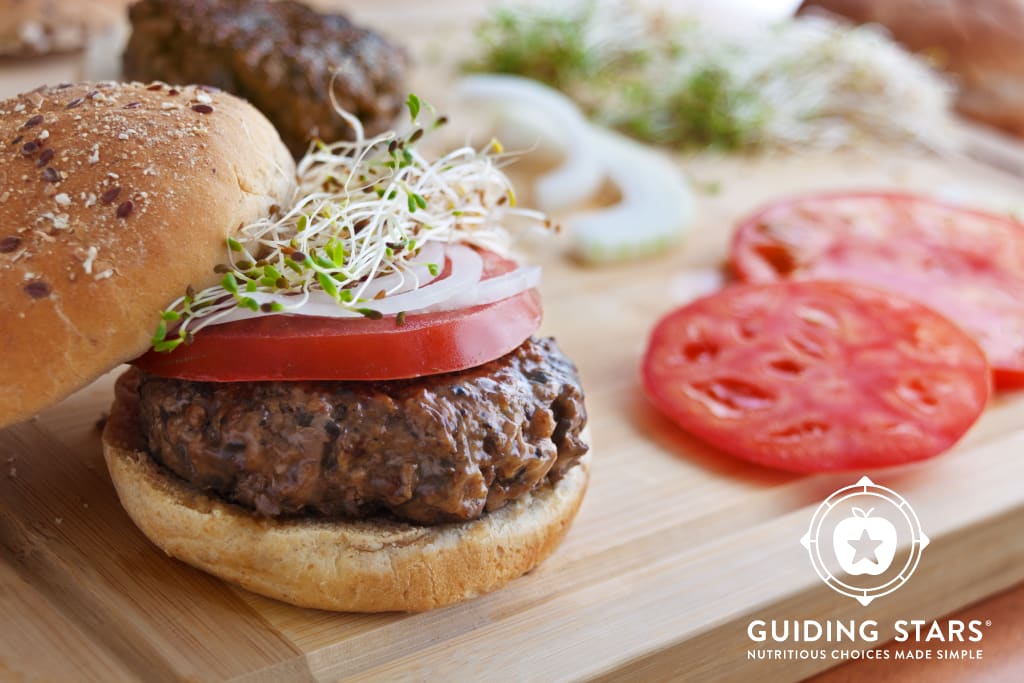
Michael Pollan’s oft-quoted advice, “Eat food. Not too much. Mostly plants,” sounds so simple and appealing. For me, it conjures soft-focus images of al fresco dining with neighbors smiling as they pass wholesome bowls of harvest bounty. Cue Enya and the scene is complete. Then, record-scratch back to reality. I realize I’m in the middle of a supermarket where I often get side-tracked. I’m surrounded by displays of über-convenient meals I know aren’t good for me and shiny boxes proclaiming to be an excellent source of the nutrient du jour. Suddenly Pollan’s advice doesn’t seem so easy to follow.
It’s easy to get influenced by the latest trend only to find out later that you’ve been duped by clever marketing that may be only partially true. Fortunately, my supermarket offers Guiding Stars. The nutritional guidance program highlights foods with good, better, or best nutritional quality. It helps me cut through the clutter and inform my decisions. Even if a product claims it’s keto-friendly or gluten-free, I know the stars will indicate whether the product has more positives than negatives per calorie. Armed with Pollan’s wisdom and with the stars as a reference, I can shop my local store with fresh eyes.
“Eat food.”
I have heard this means I should choose products with ingredients my grandmother would recognize, which sounds reasonable. I start every shopping trip in the produce aisle and feel a virtuous glow as I load a veritable rainbow of shiny, leafy, crunchy fruits and vegetables into my cart. Most of these beauties are just one wholesome ingredient. Everything I pick in this department earns at least two Guiding Stars, so I know I’m on the right track. I’ll have side-dishes and snacks covered for the week. I secretly hope I run into neighbors so they can spy my cart and mentally note how well I feed my family.
“Not too much.”
Pollan’s guidance is a good reminder that portions are important, too. Looking at the choices in the snacking aisle, I see that there are some potato chips that earn Guiding Stars. What? Maybe it’s marked wrong. I pick one and turn the package around and admit to being surprised by what I see. Even though I know that potato chips are a “sometimes food” because they are high in calories, some of these products are made with “food” – i.e., ingredients I recognize. The brand I choose lists potatoes, canola oil, and sea salt as the only ingredients. Reflecting on Pollan’s first two pieces of advice, I decide to get the 100-calorie packs of this item so that I can easily control my portions and not overdo it with a larger, multi-serving bag.
“Mostly plants.”
With the kiddie seat of my cart overflowing with produce and my smart-size salty treats, I feel like I’m well on my way with Pollan’s advice. I’d like to try to reduce our red meat consumption because I know it’s hard on our arteries and hard on the environment. I’m curious about plant-based proteins and decide to try some of the buzz-worthy alternative meat instead of our usual 90% lean ground beef, which earns 1 Guiding Star. When I find the plant-based, ground not-beef, I check the ingredients on a few products and start to think I may no longer be following rule #1, “Eat food.”
While many ingredients are easily recognizable (like pea protein), there are others (like methylcellulose) that might ring a bell for my grandmother, but not from the kitchen. Turns out, it’s used as an emulsifier and bulking agent in foods. That sounds okay, until I learn that it’s also an ingredient commonly found in laxatives. I check the shelf tag and realize that this item doesn’t earn any Guiding Stars and start to wonder if it really is better than the 90% lean ground beef that earns one star, which indicates that the product has a bit more positives than negatives.
So much for simple!
I think I’m like most shoppers when it comes to following the advice of influencers like Michael Pollan. I’m open to suggestions because I strive to feed my family nourishing food and want to do my part to protect our environment. With so many new products entering the market, and so many conflicting messages, it can be hard to follow even simple advice. Guiding Stars is helpful to me when I shop. It helps me choose products that have more positive than negative nutritional attributes per calorie, especially when I’m trying something new.
At home, I strive to assemble meals that fill half our plates with produce, keep grains whole and proteins lean and varied. We have incorporated more plants into our diets, and we try to keep our treats in small servings. We compost our table scraps, recycle empty containers and use cloth napkins to reduce waste. What ends up on our plates may reflect Pollan’s rules, but it’s not easy getting there!
- Have you tried to follow Pollan’s advice?
- What did you learn from your experiences?
- Do you ever feel either proud or ashamed of the items in your cart?